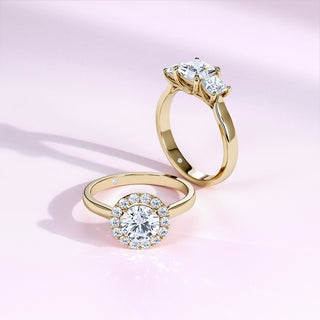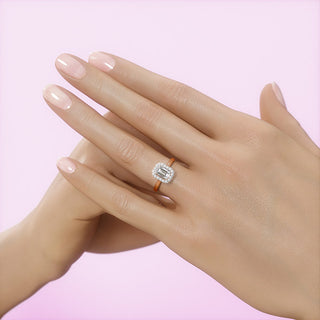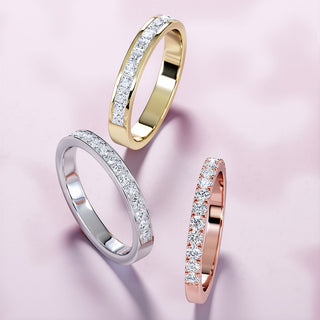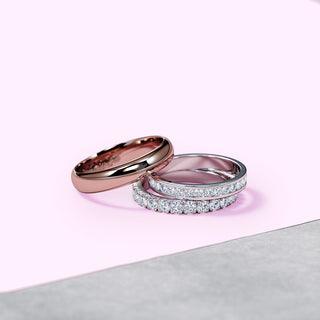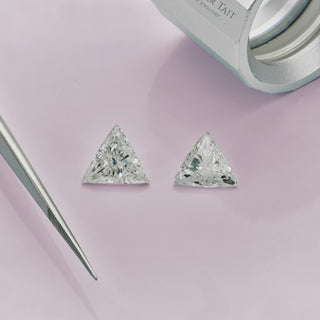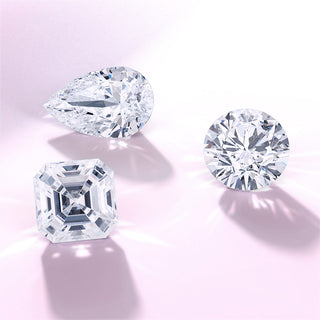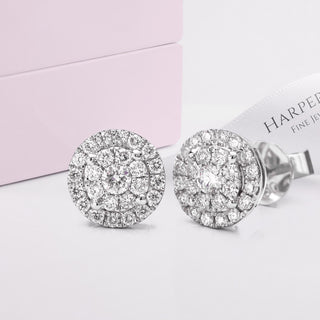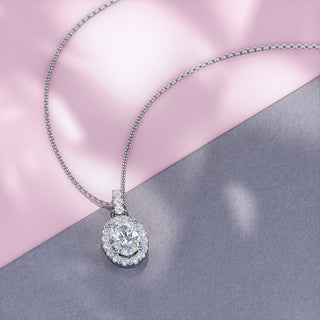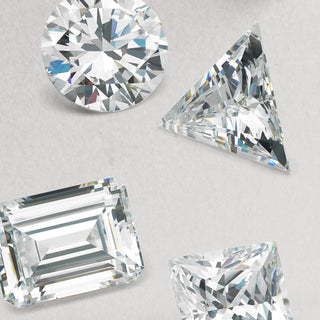What is a Radiant Diamond?
Radiant diamonds blend the shape of an emerald with the facets of a brilliant cut. The radiant is a relatively modern cut. Debuted in the late 1970s, master diamond cutter Henry Grossbard dreamed of uniting emerald and round brilliant cut diamonds. To do so, Grossbard invented an entirely new cutting technique, combining glittering, brilliant-cut facets with a geometric shape.

How Many Facets does a Radiant Diamond have?
A radiant diamond has 70 facets in a brilliant cut. As the name suggests, this faceting style is all about maximising sparkle and brilliance. While the facets are similar to that of a princess cut, a radiant diamond has cut corners, just like an emerald.
What Makes a Radiant Diamond Special?
For such a new cut, the radiant is remarkably timeless. The clean lines and cut shoulders lend a little vintage polish, modernised with brilliant facets. The radiant is a versatile cut, as suited to a classic solitaire as a glittering halo. Whichever you choose, a radiant diamond exudes glamour. Radiants are available in a range of widths, from long and narrow rectangles to squares. Choose the ratio that pleases your eye, suits your design, or flatters your finger.
How do you Know if a Radiant Diamond is Well Cut?
Of the four Cs, diamond cut is one of the most important. But as a fancy cut, there is no defined cut grading for radiant diamonds.
It’s left to diamond experts to determine what makes a radiant diamond beautiful, based on a balance of factors; the symmetry of the facets, the quality of the polishing, and the balance of size and depth.

First, we consider the visual impact of the stone - how do the fire, brightness, and scintillation appear? Second, the design - how well proportioned is the diamond? Finally, we look at the craftsmanship - how skillfully has the diamond been cut and polished? While radiant stones are not given a cut grading, there are some suggested parameters for a well-cut stone, including;
Length to width ratio: the length-to-width ratio of a diamond measures how proportional it is. Diamonds which fall within these parameters will be most pleasing to the eye, with a more distinct and even shape. As radiant diamonds are found in both square and long rectangle shapes, length-to-width ratios range from 1.00 to 1.50. An ideal ratio for a rectangular radiant cut diamond will be around 1.25, while square radiant cuts should fall between 1.00-1.05.
Table: the table is the largest, central facet of a stone. The table must be large enough to let lots of light into the diamond, but not so large that the upper facets don’t have room to sparkle. Look for a radiant diamond with a table ratio between 60 - 70%
Depth: a diamond’s depth is the top-to-bottom measurement of a diamond, from its table to culet. The depth ratio compares this measurement with the overall width of the stone. The depth affects the visual balance of a diamond and its brilliance. If a stone is too shallow or deep the light will not refract properly, escaping through the base of the diamond instead of the top. Look for a radiant diamond with a depth ratio between 60 - 70%.
Choosing a Diamond Cut Grade
As with all diamonds, pay attention to the cut of your radiant. Those glittering facets should be alive with sparkle and fire. Look for neat, matched corners and straight sides. If you choose a square stone, ensure it looks perfectly symmetrical.
Radiant diamonds are often deep in cut, meaning the size for carat weight is less than a shallower cut. You should consider the mm size of the diamond as carefully as you do the weight. Some people prefer to go for a slightly higher carat weight to achieve the show they desire. Like a round brilliant cut, the stunning facets look particularly glittering in a colourless grade with good clarity. We love how our signature VS quality and F colour showcase this beautiful cut. Eye clean and bright white, the crisp geometry and
Choosing a Radiant Diamond Colour
Like so much about choosing a diamond, colour grade comes down to personal preference. Colour is graded by letters, with the scale starting at D. A colourless diamond grade is anything from grades D to F.
Most diamond lovers prefer the cool, white hue of a ‘colourless’ diamond, which is why these shades are so highly prized. For grades G and below the diamond colour gets progressively warmer, beginning to draw tones of yellow or brown. Some customers like these warmer shades, or find they can’t easily tell the difference in a yellow or rose gold ring.
If you have chosen a platinum or white gold setting, the difference between the white metal and a warmer colour stone will be more obvious, so we advise going no lower than a grade F.
Choosing the Clarity of a Diamond
Diamond clarity varies greatly, from perfectly clean stones to those with easily visible inclusions. Truly flawless diamonds are incredibly rare. Thanks to the dizzying sparkle of a radiant diamond, small inclusions are not as visible to the naked eye. It means you can choose a slightly included grade and still enjoy an eye-clean diamond. Which is to say, you will not notice any flaws without magnification.
We advise a grade between SI1 and VS2 for brilliant cut stones under 3.00ct. At these grades you will not notice any inclusions - only incredible sparkle! For very large stones, a higher clarity may be advised. Please contact us and we can talk through your options.
Is a Radiant Cut the Diamond for You?
Why choose between geometric glamour and brilliant sparkle, when the radiant diamond delivers both? If you have a weakness for classic diamond sparkle, only a brilliant cut will do. But if you like standing out from the crowd, an under-the-radar radiant cut gets top marks for originality. Choose a solitaire engagement ring to ensure all attention is on your unusual diamond cut, or dress your radiant with a diamond halo for all-out glamour with a deco edge.


